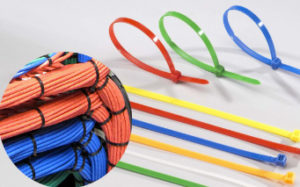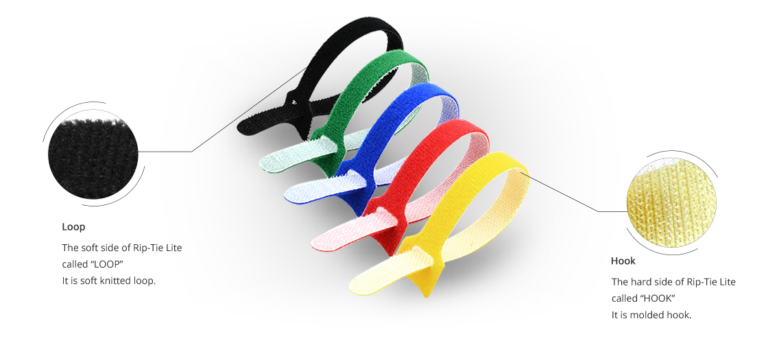Cable Ties – Easy and Affordable Solution for Cable Management
Cable ties are one of the most common and useful bits of kit in the toolbag, from the professional contractor to the DIY hobbyist. It's probably a given that we've all used a cable tie at some point in our life. Cable ties are versatile, economical, and easy to use, which has become a great solution for keeping cords, wires, and even hoses contained. Proper cable ties not only provide life-long and dependable services but also promote perfect cable management.
Types of Cable Ties
Cable ties are not created equal and they can be classified into different categories for various applications. According to the material, cable ties can divided into the following types: stainless steel cable ties, nylon cable ties, hook and loop cable ties.

Nylon Cable Ties

Hook and Loop Cable Ties
Factors to Consider When Selecting Cable Ties
Since there are so many types of cables tie on the market, some people may feel confused about which one to choose. Here are some factors to consider when choosing the right cable ties for your applications.
Material
Cable ties are available in different materials, each with its own specific properties. Plastic materials normally undergo property loss due to oxidation caused by exposure to high temperatures. Low temperature exposure will also make most plastics more brittle during the exposure, but little property loss occurs when the material is returned to room temperatures. Nylon ties can offer good resistance to weather and ultraviolet rays in low-temperature environments. For applications in harsher environments that require extra durability in the face of heat, chemicals and other corrosive elements, consider stainless steel cable ties.
Design
Once you have determined that you need a certain material to meet your needs, think of the construction needed. Cable ties made of the same material can come in a variety of constructs. Nylon cable ties can be used for various applications such as managing and securing wire harnesses, strain relief and wire management in solar applications, desktop and video cable management, or even temporary child locks on your cabinets. There are also cable ties with a metal barb in the head which reinforces the locking mechanism. These tend to be used in applications that require infinite adjustment positions since it does not use griping teeth. Contour cable ties, which have teeth on the outside of the tie, tend to be much less abrasive to wire insulation under vibration and therefore a product of choice in the aerospace industry.
Length
Cable tie length can vary greatly. Think about an application in which you have a wire bundle that is 4” in diameter, but you only have a 1” diameter cable tie. This would not work. You need to match the maximum bundle diameter of the cable tie with the diameter of the wire bundle. Always be cognizant of your application so that you do not purchase a tie that is too short. If they are a little longer, you can always cut off the excess tie length, but from an economical standpoint, choosing the proper length will provide the best value.
Environment
Will the cable ties be installed outdoors? Will they have direct exposure to sunlight? Are you working in a hazardous environment like a chemical plant in which the ties might get exposure to various chemicals or acids? Is it a high heat application in which flammability and thermal properties become an issue? All of these questions should be answered before choosing the cable tie. For instance, a standard cable tie is usually made of nylon 6.6. But there are many types of Nylon, and choosing the right one is essential. If your application includes exposure to the elements or high heat exposure, the weather resistant nylon 6.6 material, or a heat stabilized nylon 6.6 material would be ideal. With weather resistant nylon 6.6, you typically have a 7-9 year life expectancy with regards to UV resistance, as opposed to 1-2 years with standard nylon 6.6. Heat stabilized nylon 6.6 has a continuous temperature range of -76°F to 239°F, which is 54 degrees higher than standard nylon 6.6. It is important to know the temperature conditions in order to select the optimal cable tie for your application.
Strength
After making clear the above mentioned factors, now you can determine the strength of the tie that you will need. The way we measure cable tie strength is by obtaining its tensile strength. Tensile strength is measured in Newton or pounds and is basically the breaking point of a cable tie. The higher the tensile strength, the stronger the tie. This is an important factor to consider when you are securing mission critical wire harnesses.
Cheap Cable Ties Solutions
Cable tie is an easy and affordable solution for cable management. With the usage of cable ties, handing great mess of cables will not be a problem. The following table lists three types of cost-effective cable ties from FS.com. Combine the above factors and select the most suitable cable tie for your project now.
| Product | Descriptions |
|---|---|
| Nylon cable ties | available size: 6*0.15in,4*0.1in;8*0.2in; available in various colors |
| Hook and loop cable tie | available size: 10*0.5in,1000*0.48in; available in various colors |
You might be interested in
Email Address

-
PoE vs PoE+ vs PoE++ Switch: How to Choose?
Mar 16, 2023














